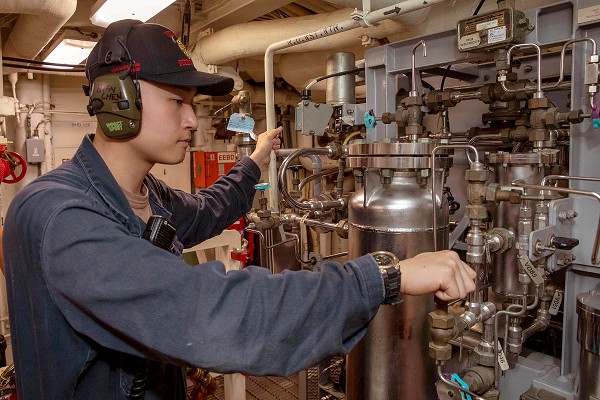
Atlantic Ocean, (March 30, 2023): There are few things more terrifying to a Sailor than being marooned at sea, surrounded by water, dying of thirst. In the above photo by MC2 Cryton Vandiesal, Hull Maintenance Technician Fireman Wenwei Chen aligns a reverse osmosis demineralizer aboard the Arleigh Burke-class guided missile destroyer USS Nitze. The Nitze is part of the George H.W. Bush Carrier Strike Group that is on a scheduled deployment to Naval Forces Europe with the U.S. 6th Fleet.
The challenge of maintaining an adequate water supply at sea had bedeviled mariners for centuries. In primitive times, a captain would carry as much water as possible because, once out of sight of land, their lives depended on it. Landlubbers will ask, “Why didn’t they just boil sea water to drink?” The answer is simple, boiling seawater does not remove salt, too much of which is deadly for humans. Fortunately, today’s mariners have the technology to convert enormous amounts of saltwater into drinking water through a process known as distillation. Distillation is accomplished by heating seawater to the boiling point to vaporize it. The vapors condense into a liquid which removes impurities and contaminants.
The next step in generating fresh water aboard a warship is through Osmosis, a process to desalinate ocean water by passing it through a thin, porous membrane that acts as both a filter and a salt barrier. Reverse Osmosis requires multiple stages of filtration to strip off additional minerals and other solid contaminants. In the final filtration stage, essential minerals are added back into the water to ensure Sailors receive the potable nutrition from that is healthy to drink.
So, how does the Navy provide fresh water to ships as large as an aircraft carrier?
The current design for Navy ships requires standardized water purification plants of two capacities: 12,000-gallons per day reverse osmosis plants and 100,000 gallons distilling plants. A modern aircraft carrier produces up to 200,000 gallons of drinkable water daily.
But not all water meant for drinking. Ships use this fresh water for cooking, washing, bathing, and even to cool important machinery onboard. Today’s Sailors and Marines can rest assured that they will never suffer the fate of the “Ancient Mariner.”


